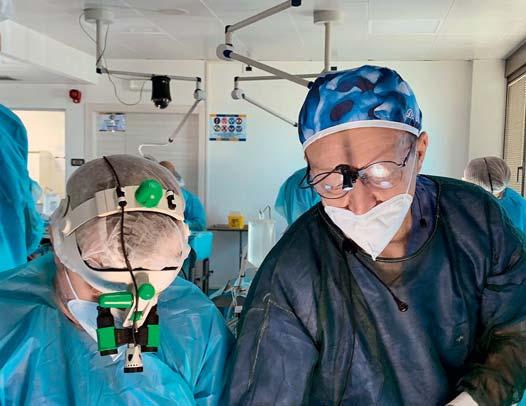
5 minute read
“Everything may work in the short term – but not necessarily in the long-term.”







Biomaterials’ role in long-term success “Everything may work in the short term – but not necessarily in the long-term.”
Dr. Mario Roccuzzo | Italy Corso Tassoni Alessandro 14, 10143 Torino
Interview conducted by Dr. Marjan Gilani
What makes a biomaterial “premium”? We discussed with Dr. Mario Roccuzzo, Italy, about design, manufacturing standards, long-term outcomes – and his journey of using biomaterials in the last 30 years.
Dr. Mario Roccuzzo as the scientific coordinator of the study day event: “Long-term success. How to select the best therapy for the patients?” Torino, September 2017 Dr. Roccuzzo, you have treated many compromised patients with bone defects. What was the first biomaterial you ever used?
Dr. Roccuzzo: It was Biocoral®, a resorbable coralline calcium carbonate graft material. Later I used several other bone substitutes, until I found Geistlich Bio-Oss®, and then Geistlich Bio-Oss® Collagen, and I continue to use them.
What has changed over those years?
A lot of things. But patient expectation is the most prominent one. In the past, implants were so unique, and patients were always happy, as long as they had a replacement for their lost teeth. Nowadays, most patients have extremely high demands. Particularly my patients, who are usually referred to me because of the complications they have.
Is it possible to avoid recurrent complications?
In the real world, complications happen no matter what.¹, ² We treat patients with high peri-implantitis risk factors and follow them for over 20-years. There is no way to completely avoid complications, but there are certain approaches and choices we can make to reduce their recurrence. Among them is the choice of biomaterials.², ³
How does the choice of biomaterial contribute to predictability?
Certainly every medical device should be tested in vitro and in the clinic and have the right physical and biological properties to comply with the medical device regulations.³ But as clinicians, one of the most important criteria we look for is long-term predictability. And when I say long-term, I mean a minimum of 10-years. When I look into the scientifi c literature, most studies are short-term. It seems everyone is in a rush to publish.
They often forget that in the short-term everything we do may work, but not necessarily in the long-term.
Has this happened to you? That you were convinced of a biomaterial or treatment concept but over time it turned out to be unsuccessful?
There was a time I was convinced that synthetic biomaterials would be the right choice, but their behavior in the long run was not what I expected, so I stopped using them.
What drives innovation in biomaterial science? Unmet clinical needs?
Research is part of human nature. We always want more: better products, better solutions, less expensive procedures, less risk and unlimited supply. Even with excellent results we always want better outcomes, and that’s good.
Are you cautious when it comes to new products?
In general, when a company that has a reputation for doing things properly launches a new product, clinicians are open to trying it. Nevertheless, we should always be cautious, especially when using new products in diffi cult cases. It’s not much diff erent than the automobile industry: cars are tested and introduced to the market after hundreds of tests, but once in the market, they may have a problem and must be recalled. We don’t want this to happen to our patients. This is why companies with premium products advertise that their products have been used for so many decades in so many million patients and in so many clinical studies. This is the ultimate proof that a product works.
Are your patients curious about the biomaterials they get?
We have two diff erent types of patients: those who don’t care what treatment we use, and those who want to know everything – what we use, and how we use it. These patients even check the company website and read about the products. But in the end, if we want to promote highend dentistry, we should explain products to our patients and tell them why we use them. This is part of patient education and a way to improve quality of care. The more we ask patients to be responsible for compliance and hygiene, the more information we need to give them. And they appreciate it.


Dr. Mario Roccuzzo giving a hands-on workshop on the reconstruction of hard and soft tissue for esthetic, function, and reduced risk of complications. Verona, May 2021
Do you have a biomaterial wish list?
One is a problem-free bone block for vertical bone augmentation: avoiding harvest, vascularization issues and other complications. Also, a soft tissue alternative as good as a connective tissue graft. A thick connective tissue graft is still my number one choice when I treat peri-implantitis, but maybe in the future we will have an even better substitute biomaterial.
What is your final recommendation for future research and development?
Stay cautious interpreting the outcome of studies with short-term follow-up, and invest in more long-term studies.
References 1 Giovannoli JL et al.: Int Dent J 2019 ;69 Suppl 2:7-11. (consensus report) 2 Jepsen S, et al.: J Clin Periodontol. 2019;46 Suppl 21:277-86. (consensus report) 3 Sanz M, et al.: J Clin Periodontol. 2019;46 Suppl 21:82-91. (consensus report).










